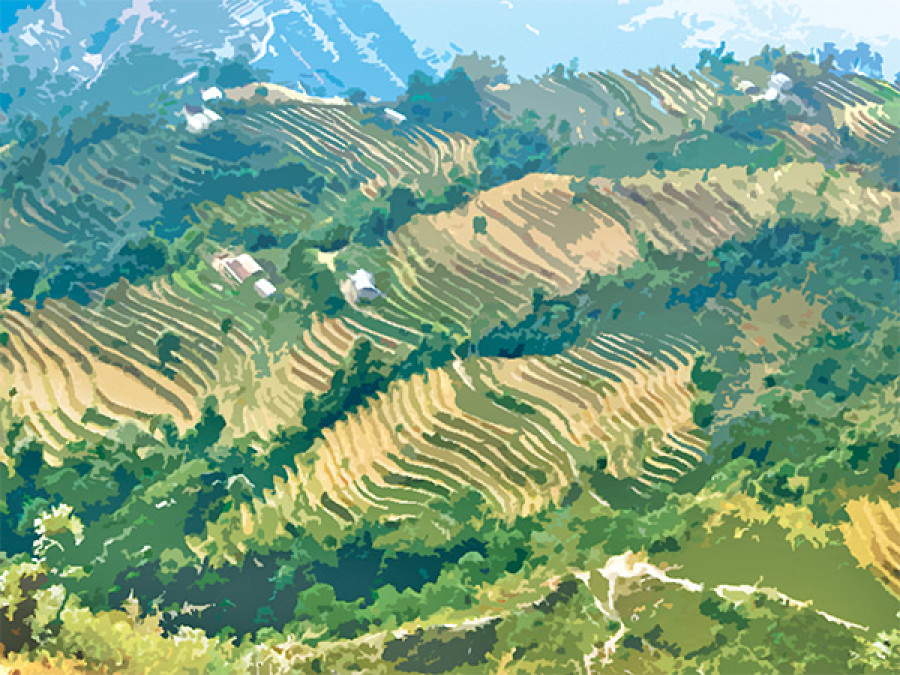Opinion
Outside farms
Availability of market and transport are the main prerequisites for developing enterprises in the hill and mountains.
Padam Bhandari
Starting an enterprise
A shift from subsistence-based economic activities to income-oriented business demands a functional market. This in turn necessitates bearing market-related risks on the part of producers in addition to other uncertainties. As a result, the risk bearing function of producers becomes an essential element in any diversification of economic activity from subsistence agriculture. Thus, an enterprise implies a production unit, product, and risk-bearing function. But in the hilly and mountainous areas of Nepal, the small scale of the resource base, inaccessibility to markets, and the limited scope for the diversification of economic activities due to small, scattered, and fragile resource limits the risk bearing capacity of entrepreneurs.
Nonetheless, a careful selection of an enterprise might help reduce risk. This is a very critical task, owing to factors such as inaccessibility, thin spread of resources and materials, lack of forward and backward linkages, and lack of infrastructure and services for commercial production. Similarly, the availability of food either from within the area or from outside is a very important precondition to the promotion of promising agriculture-related enterprise.
Different prerequisites
Basically, the stages of agriculture development and products depend on self-use for household needs, exchange under traditional systems, and sale in the market. The degree of enterprise diversification in an area depends upon the level of resource base and accessibility. Generally, livestock-based enterprises like draft power and manure, milk, milk products, meat, and wool are suitable for places with minimum transport, communication, market channels, and that possess low marketing risk. On the other hand, enterprises based on diversified farming like fruits, vegetables, cash crops, plantation crops pose greater marketing risk and require more information on marketing and involve wider markets and unpredictable fluctuations. In case of natural resource-based enterprises like water, forest, and non-timber forest products along with hill and mountain tourism, outsiders seem to reap more benefits.
The value-addition to agricultural produce by processing and manufacturing enterprises consist of mere growing, extracting, and collection of material with very little processing. The income from doing so is bare minimum. If an area has excellent transport, communication, access to technologies, and markets, the enterprise can take off as processing takes place locally and the income derived from the processed output increases significantly. In addition, in developed areas, there is less risk of loss in the transit of fruits, vegetables, milk etc.
Mountain markets
Many enterprises in hilly and mountain areas are based on traditional skills that coexist with any of those mentioned above to a varying extent and have variable potentials for income generation. They are mostly, but not always, based on local raw materials, cultural traditions, and past reputation, for example handicrafts, special woollen products, metal crafts and cultural artefacts. But the stages of enterprises development may not necessarily follow in the sequence described above. Business enterprises in hilly and mountainous areas generally tend to be underdeveloped with a wide variety of goods and services primarily catering to the subsistence need of local people. Most are tiny in size and household- based in character, secondary to main household ability, such as agriculture, to earn cash for household needs rather than to make profit.
The most common products with a comparative advantage in the hills and mountains and those that have seen rapid development are new niche-based products. For example, organic apples from Jumla, fresh vegetables from Guranse in Surkhet and Kapurkot in Salyan, akabare khursani from Eastern Nepal, snowball cauliflower seeds from Dolpa, etc. These products have demonstrated rapid growth in most areas while other enterprise and products have shown a variable growth performance.
Easing constraints
Shifting from subsistence to market-oriented agriculture, livestock farming could be easy for many, as most households possess some resource and skills in these sectors. But at the same time, the shift should gradual and after being assured of food security either through subsidies or through loans. Above all, availability of market and transport are two main prerequisites for driving enterprises in the hill and mountains. It
has also been observed that providing trainings to few enterprising persons in places with good transport and a market can help agricultural enterprises expand further. Other incentives could be tax exemption for new enterprises in remote areas, incentives for scientists and technologists, and linkage development.
To conclude, availability of markets and marketing constraints hinder development of enterprises in the hills and mountains as most enterprises are small and not individually capable of product and market development and sale in distant locations. Due to marketing constraints, the chances of new enterprises are further reduced. Prior production purchase orders of products are also very rare. Organised market promotion and marketing are essential for of small enterprises. Therefore, producers based marketing organisations have greater chances to succeed insofar as they can prevent buyers from playing small producers off against each other, thus improving terms of trade and also pooling resources for market promotion.
Bhandari works as an advisor at SNV Nepal




 8.12°C Kathmandu
8.12°C Kathmandu










